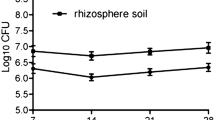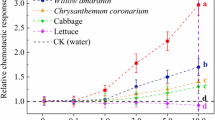Abstract
Pantoea (formerly Enterobacter) agglomerans YS19 is a dominant diazotrophic endophyte isolated from rice (Oryza sativa cv. Yuefu) grown in a temperate-climate region in west Beijing, China. In vitro adsorption and invasion of YS19 on host plant root were studied in this research. Adsorption of YS19 on rice seedling roots closely resembled the Langmuir adsorption and showed a higher adsorption quantity than the control strains Paenibacillus polymyxa WY110 (a rhizospheric bacterium from the same rice cultivar) and Escherichia coli HB101 (a general model bacterium). Adsorption dynamics study revealed high rates and a long duration of the YS19-rice root adsorption process. Adsorption of YS19 was mainly observed on the root hair, though which it enters the plant. This in vitro adsorption study revealed an apparent strong interaction between YS19 and rice at the early endophyte-host recognition stage.



Similar content being viewed by others
References
Achouak W, Heulin T, Villemin G, Balandreau J (1994) Root colonization by symplasmata forming Enterobacter agglomerans. FEMS Microbiol Ecol 13:287–294
Amellal N, Burtin G, Bartoli F, Heulin T (1998) Colonization of wheat roots by an exopolysaccharide-producing Pantoea agglomerans strain and its effect on rhizosphere soil aggregation. Appl Environ Microbiol 64:3740–3747
De Araujo WL, Maccheroni WJ, Aguilar-Vildoso CI, Barroso PA, Saridakis HO, Azevedo JL (2001) Variability and interactions between endophytic bacteria and fungi isolated from leaf tissues of citrus rootstocks. Can J Microbiol 47:229–236
Duan J, Yi T, Lu Z, Shen D, Feng Y (2007) Pantoea agglomerans YS19 forms multicellular symplasmata via cell aggregation. FEMS Microbiol Lett 270:220–226
Feng Y, Shen D, Dong X, Song W (2003) In vitro symplasmata formation in the rice diazotrophic endophyte Pantoea agglomerans YS19. Plant Soil 255:435–444
Feng Y, Shen D, Song W (2006) Rice endophyte Pantoea agglomerans YS19 promotes host plant growth and affects allocations of host photosynthates. J Appl Microbiol 100:938–945
Francis CA, Obraztova AY, Tebo BM (2000) Dissimilatory metal reduction by the facultative anaerobe Pantoea agglomerans SP1. Appl Environ Microbiol 66:543–548
Kluepfel DA (1993) The behavior and tracking of bacteria in the rhizosphere. Annu Rev Phytopathol 31:441–472
Koda N, Asaeda T, Yamade K, Kawahara H, Obata H (2001) A novel cryoprotective protein (CRP) with high activity from the ice-nucleating bacterium, Pantoea agglomerans IFO12686. Biosci Biotechnol Biochem 65:888–894
Nunes C, Usall J, Teixido N, Fons E, Vinas I (2002) Post-harvest biological control by Pantoea agglomerans (CPA-2) on Golden Delicious apples. J Appl Microbiol 92:247–255
Silbey RJ, Alberty RA (2001) Surface dynamics. In: Silbey RJ, Alberty RA (eds) Physical chemistry, 3rd edn. Wiley & Sons, New York, pp 866–875
Tabary F, Balandreau J, Bourrillon R (1984) Purification of the rice embryo lectin and its binding to nitrogen-fixing bacteria from the rhizosphere of rice. Biochem Biophys Res Commun 119:549–555
Wright SA, Zumoff CH, Schneider L, Beer SV (2001) Pantoea agglomerans strain EH318 produces two antibiotics that inhibit Erwinia amylovora in vitro. Appl Environ Microbiol 67:284–292
Yang H, Sun X, Song W, Wang Y, Cai M (1999) Screening, identification and distribution of endophytic associative diazotrophs isolated from rice plants. Acta Bot Sin 41:927–931
Yao W, Wang Y, Han J, Li L, Song W (2004) Purification and cloning of an antifungal protein from the rice diseases controlling bacterial strain Paenibacillus polymyxa WY110. Acta Genet Sin 31:878–887
Acknowledgments
This work was supported by National Natural Science Foundation of China 30400002. The authors are grateful to Prof. T. Han, Mr. C. Wu, and Dr. W. Hou (Institute of Crop Sciences, Chinese Academy of Agricultural Sciences) for their constructive suggestions.
Author information
Authors and Affiliations
Corresponding author
Rights and permissions
About this article
Cite this article
Miao, Y., Zhou, J., Chen, C. et al. In Vitro Adsorption Revealing an Apparent Strong Interaction Between Endophyte Pantoea agglomerans YS19 and Host Rice. Curr Microbiol 57, 547–551 (2008). https://doi.org/10.1007/s00284-008-9240-7
Received:
Revised:
Accepted:
Published:
Issue Date:
DOI: https://doi.org/10.1007/s00284-008-9240-7




